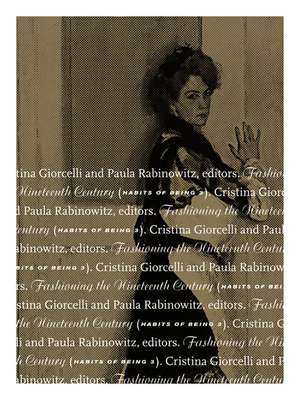Fashioning the Nineteenth Century: Habits of Being 3
Editat de Cristina Giorcelli, Paula Rabinowitzen Limba Engleză Paperback – 7 aug 2014
In nineteenth-century Europe and the United States, fashion—once the province of the well-to-do—began to make its way across class lines. At once a democratizing influence and a means of maintaining distinctions, gaps in time remained between what the upper classes wore and what the lower classes later copied. And toward the end of the century, style also moved from the streets to the parlor. The third in a four-part series charting the social, cultural, and political expression of clothing, dress, and accessories, Fashioning the Nineteenth Century focuses on this transformative period in an effort to show how certain items of apparel acquired the status of fashion and how fashion shifted from the realm of the elites into the emerging middle and working classes—and back.
The contributors to this volume are leading scholars from France, Italy, and the United States, as well as a practicing psychoanalyst and artists working in fashion and with textiles. Whether considering girls’ school uniforms in provincial Italy, widows’ mourning caps in Victorian novels, Charlie’s varying dress in Kate Chopin’s eponymous story, or the language of clothing in Henry James, the essays reveal how changes in ideals of the body and its adornment, in classes and nations, created what we now understand to be the imperatives of fashion.
Contributors: Dagni Bredesen, Eastern Illinois U; Carmela Covato, U of Rome Three; Agnès Derail-Imbert, École Normale Supérieure/VALE U of Paris, Sorbonne; Clair Hughes, International Christian University of Tokyo; Bianca Iaccarino Idelson; Beryl Korot; Anna Masotti; Bruno Monfort, Université of Paris, Ouest Nanterre La Défense; Giuseppe Nori, U of Macerata, Italy; Marta Savini, U of Rome Three; Anna Scacchi, U of Padua; Carroll Smith-Rosenberg, U of Michigan.
The contributors to this volume are leading scholars from France, Italy, and the United States, as well as a practicing psychoanalyst and artists working in fashion and with textiles. Whether considering girls’ school uniforms in provincial Italy, widows’ mourning caps in Victorian novels, Charlie’s varying dress in Kate Chopin’s eponymous story, or the language of clothing in Henry James, the essays reveal how changes in ideals of the body and its adornment, in classes and nations, created what we now understand to be the imperatives of fashion.
Contributors: Dagni Bredesen, Eastern Illinois U; Carmela Covato, U of Rome Three; Agnès Derail-Imbert, École Normale Supérieure/VALE U of Paris, Sorbonne; Clair Hughes, International Christian University of Tokyo; Bianca Iaccarino Idelson; Beryl Korot; Anna Masotti; Bruno Monfort, Université of Paris, Ouest Nanterre La Défense; Giuseppe Nori, U of Macerata, Italy; Marta Savini, U of Rome Three; Anna Scacchi, U of Padua; Carroll Smith-Rosenberg, U of Michigan.
Preț: 125.72 lei
Preț vechi: 170.98 lei
-26% Nou
Puncte Express: 189
Preț estimativ în valută:
24.06€ • 25.18$ • 20.02£
24.06€ • 25.18$ • 20.02£
Carte indisponibilă temporar
Doresc să fiu notificat când acest titlu va fi disponibil:
Se trimite...
Preluare comenzi: 021 569.72.76
Specificații
ISBN-13: 9780816687473
ISBN-10: 0816687471
Pagini: 304
Ilustrații: 36
Dimensiuni: 152 x 203 x 23 mm
Greutate: 0.4 kg
Ediția:1
Editura: University of Minnesota Press
Colecția Univ Of Minnesota Press
ISBN-10: 0816687471
Pagini: 304
Ilustrații: 36
Dimensiuni: 152 x 203 x 23 mm
Greutate: 0.4 kg
Ediția:1
Editura: University of Minnesota Press
Colecția Univ Of Minnesota Press
Notă biografică
Cristina Giorcelli is professor of American literature at the University of Rome Three.
Paula Rabinowitz is professor of English at the University of Minnesota.
Cuprins
Contents
Preface and AcknowledgmentsClothing, Dress, Fashion: An Arcade
Introduction: Fashioning a Century
Cristina Giorcelli1. Psychoanalytic Views of Cross-Dressing and TransvestismBianca Iaccarino Idelson2. Our Job Is to Create Beauty: A Personal Memoir of La PerlaAnna Masotti3. Modernity Clothing: Birthing the Modern Atlantic/Birthing the Modern RepublicCarroll Smith-Rosenberg4. Garment of the Unseen: The Philosophy of Clothes in Carlyle and EmersonGiuseppe Nori5. An Emblem of All the Rest: Wearing the Widow’s Cap in Victorian LiteratureDagni Bredesen6. Clothing the Marmorean Flock: Sartorial Historicism and The Marble FaunBruno Monfort7. FlorenceBeryl Korot8. Accessories to the Crime in What Maisie KnewClair Hughes9. Costume and Form: D’Annunzio and Mutable AppearancesMarta Savini10. Shawls Redefine Womanhood in American Literature, 1850s-1920sAnna Scacchi11. A Lovely Little Coffee-Colored Dress: Education, Female Identity, and Dress at the End of the Nineteenth CenturyCarmela Covato12. Gender and Power: Dressing “Charlie”Cristina Giorcelli13. Imaginative Habits: Fantasies of Undressing in The AmbassadorsAgnès Derail-ImbertCoda: Seen and ObscenePaula Rabinowitz
Contributors
Preface and AcknowledgmentsClothing, Dress, Fashion: An Arcade
Introduction: Fashioning a Century
Cristina Giorcelli1. Psychoanalytic Views of Cross-Dressing and TransvestismBianca Iaccarino Idelson2. Our Job Is to Create Beauty: A Personal Memoir of La PerlaAnna Masotti3. Modernity Clothing: Birthing the Modern Atlantic/Birthing the Modern RepublicCarroll Smith-Rosenberg4. Garment of the Unseen: The Philosophy of Clothes in Carlyle and EmersonGiuseppe Nori5. An Emblem of All the Rest: Wearing the Widow’s Cap in Victorian LiteratureDagni Bredesen6. Clothing the Marmorean Flock: Sartorial Historicism and The Marble FaunBruno Monfort7. FlorenceBeryl Korot8. Accessories to the Crime in What Maisie KnewClair Hughes9. Costume and Form: D’Annunzio and Mutable AppearancesMarta Savini10. Shawls Redefine Womanhood in American Literature, 1850s-1920sAnna Scacchi11. A Lovely Little Coffee-Colored Dress: Education, Female Identity, and Dress at the End of the Nineteenth CenturyCarmela Covato12. Gender and Power: Dressing “Charlie”Cristina Giorcelli13. Imaginative Habits: Fantasies of Undressing in The AmbassadorsAgnès Derail-ImbertCoda: Seen and ObscenePaula Rabinowitz
Contributors
Recenzii
"A thought-provoking volume that offers key insights into the interconnections among culture, literature, and fashion."—CHOICE
"Fashioning the Nineteenth Century proves to be a remarkable instrument to refine our knowledge of narrative worlds whose territories are inhabited also by fashion as part of the common humanistic heritage."—Fashion Theory
"Fashioning the Nineteenth Century proves to be a remarkable instrument to refine our knowledge of narrative worlds whose territories are inhabited also by fashion as part of the common humanistic heritage."—Fashion Theory
